|
|
THE
STATE EDUCATION DEPARTMENT /
THE UNIVERSITY OF THE STATE OF NEW YORK / ALBANY, NY
12234 |
|
TO: |
The Honorable the Members of the Board
of Regents |
|
FROM: |
Johanna
Duncan-Poitier
|
|
COMMITTEE: |
Higher
Education and Professional Practice |
|
TITLE OF
ITEM: |
Implementing the Regents Teaching
Policy: Consideration of Modifications to the Policy Based on Input from
the Field |
|
DATE OF
SUBMISSION: |
August
27, 2004 |
|
PROPOSED
HANDLING: |
Discussion
|
|
RATIONALE FOR
ITEM: |
To inform
the Regents and seek preliminary feedback |
|
STRATEGIC
GOAL: |
Goals 1,
2, 3, and 4 |
|
AUTHORIZATION(S): |
|
SUMMARY:
At your February 2004 meeting, Regents
McGivern, Johnson and I provided the full Board of Regents with an overview of
the progress made in implementing the Regents 1998 Teaching Policy “Teaching to Higher Standards: New York’s
Commitment.” In
May 2004, I provided the Higher Education and Professional Practice Committee
with an update on some of the issues that the Committee will be discussing over
the next few months. During the May
discussion, the Committee heard about three issues specifically related to the
Regents Teaching Policy. Over the last year, members of the Board of Regents and
State Education Department (SED) staff have had numerous conversations with the
field concerning the impact of certain regulations affecting teacher education
programs and have been asked to consider a proposal for some modifications. These three specific regulations related
to teacher education programs have been cited most often as requiring additional
review and consideration:
1.
Full-time
faculty:
The requirement that institutions of higher education “shall provide sufficient
numbers of qualified, full-time faculty to . . . ensure that the majority of
credit-bearing courses in the program are offered by full-time
faculty.”
2.
Faculty
workload: “Faculty teaching assignments shall not exceed 12
semester hours per semester for undergraduate courses, or nine semester hours
per semester for graduate courses, or 21 semester hours per academic year for
faculty who teach both undergraduate and graduate courses, while still providing
sufficient course offerings to allow students to complete their programs in the
minimum time required for earning the degree. ”
- Three-year
Master’s: To qualify for a Professional
certificate (formerly known as Permanent certificate), teachers must now
complete a Master’s degree or higher within three years of receiving the
Initial certificate or apply for a one-year extension to complete the
degree. New teachers were previously required to complete the degree in
five years.
The Regents Teaching Policy, originally
adopted in 1998, remains strong and continues to guide the field. One of the reasons for the Policy’s
continued relevance is the commitment the Regents made to continually monitor
the impact of the Policy and to make adjustments and modifications as
needed. Fulfilling that commitment,
the attached report proposes the following modifications to the Policy based on
extensive input from the field:
1.
Consider moving toward a performance-based system
that continues to emphasize high standards of quality while giving college and
university leadership, with a record of achievement, more discretion and
flexibility to develop staffing plans that are consistent with their program
design by eliminating the full-time faculty and faculty workload regulatory
requirements for institutions that:
§
Achieve and continue to maintain the new Regents
required accreditation for their teacher education program(s),
and
§
Meet or exceed the established institutional pass
rate (80 percent) on teacher certification
examinations.
2.
Consider providing teachers with Initial*
certificates the flexibility to complete the Master’s or advanced degree
necessary for Professional certification within the five-year period previously
allowed instead of three years.
Data on
the faculty requirements has been compiled by the Department and is provided in
Attachment A. Additionally, the
Department is surveying the presidents of all 113 New York State colleges and
universities with teacher education programs to get their feedback on this
important policy question. Survey
results will be shared with the Regents at the September meeting. Attachment B is a copy of the
survey.
*As of 2/04, the former Provisional Certificates are now Initial Certificates and the former
Permanent Certificates are now
Professional
Certificates
Attachments
The regents Teaching policy: modifications for
consideration
In
1998, the Regents adopted a rigorous new teaching policy to improve student
learning and achievement by ensuring that all teachers are prepared to help
students reach high standards. Many stakeholders and partners were involved in
the development of the new standards for teachers and teacher education
programs.
Since
1998, Regents and Department efforts related to teaching have been focused on
carrying out the teaching policy.
Now, more than five years later, significant progress has been made on
the implementation of the policy. While there is more work to do on
implementation, an independent, formal evaluation of the effectiveness of the
policy is essential. Professor James Wyckoff is conducting independent
research in collaboration with Professor R. Hamilton Lankford and Research
Scientist Donald Boyd of the State University of New York at Albany and
Professor Pam Grossman and Assistant Professor Susanna Loeb of Stanford
University. This research will
examine teacher preparation and provide quantifiable data to identify the most
effective teacher education program elements, their impact on issues, including
the production of quality teachers as evidenced by gains in student learning in
the New York City public schools, and retention of teachers. The research will provide us with
important information on effective practices and approaches to preparing
teachers who have the most positive impact on student learning outcomes.
Phase I of implementation of the Regents
Teaching Policy resulted in accomplishments that include: the modification and
re-registration of teacher preparation programs consistent with the Regents
standards; the accreditation of teacher education programs; the elimination of
temporary licenses for teachers; the development of district plans for
professional development; and targeted teacher recruitment efforts for shortage
areas. Phase II of
implementation of the Regents Teaching Policy will focus on providing support
for school district recruitment needs for teachers in certain subjects (math,
science, special education and bilingual education), improving the school
environment, supporting retention and ensuring the effectiveness of all
teachers. At the same time, the
independent evaluation of the effectiveness of a sample of the first cohort of
new teachers prepared under the new Regents standards will provide us with data
on the effectiveness of the Regents Policy and the impact the new standards have
on teaching and learning.
Another critical element of the second phase
of implementation is the consideration of modifications to the Policy.
Feedback from the
Field
The 1998 Teaching Policy included a
commitment for ongoing monitoring of the implementation and impact of the Policy
and a plan to consider adjustments and modifications as necessary to reflect the
educational environment.
Improved communications with the field have enabled the Regents and
Department staff to stay current on emerging issues in higher education. Through a number of venues, including
the statewide Call to Teaching
forums, meetings with the Commissioner’s Higher Education Advisory
Council, meetings with college and university presidents and other
institutional leaders, as well as regular communications with the
field, partners and
stakeholders have brought issues that warrant additional consideration and
review to the attention of the Board of Regents and the Department.
In May, the Regents Committee on Higher
Education and Professional Practice began discussing the three regulations
related to teacher education programs that have been cited most often as
requiring Regents and Department review and
consideration:
1.
Full-time
faculty:
The requirement that institutions of higher education “shall provide sufficient
numbers of qualified, full-time faculty to . . . ensure that the majority of
credit-bearing courses in the program are offered by full-time
faculty.”
and:
2.
Faculty
workload: “Faculty teaching assignments shall not exceed 12
semester hours per semester for undergraduate courses, or nine semester hours
per semester for graduate courses, or 21 semester hours per academic year for
faculty who teach both undergraduate and graduate courses, while still providing
sufficient course offerings to allow students to complete their programs in the
minimum time required for earning the degree.”
There appears to be agreement on the value of
having a majority of full-time faculty for all academic programs. College and
university leadership at institutions with teacher education programs have
requested more flexibility, however, to develop staffing plans that are
consistent with the changing needs of their programs (i.e., enrollment
fluctuations and the need to offer specific courses to meet the demands for
teachers in certain subject areas, etc.).
While some deans and program chairs have told us the full-time faculty
and faculty workload mandates help ensure that their programs are provided with
sufficient resources to meet their academic mission, presidents of institutions
with teacher education programs, as well as some deans, program chairs, faculty,
and representatives of higher education organizations, including the
Commission on Independent
Colleges and Universities (cIcu), have described specific unanticipated impacts
of the full-time faculty and faculty workload requirements. For
example:
§
The field has reported
concern about the increased cost to institutions resulting from the requirements
in the way of faculty salaries, costs of recruiting full-time
faculty, etc.
§
Institutions have reported being forced to reduce,
rather than expand, the number of programs and courses they offer, jeopardizing
their ability to prepare teachers to serve students in diverse school
settings.
§
The regulations are said
to have caused a severe reduction in teacher education programs at the graduate
level, as well as the undergraduate level, thereby reducing teachers’ graduate
opportunities in
various regions of the State.
§
A number of institutions reported having to increase
class size and/or their faculty/student ratio to defray the costs associated
with meeting full-time faculty and faculty workload
requirements.
§
A number of institutions
have been forced to reduce the academic and support services available to
prospective teachers since the increasing costs necessary to meet these
requirements cannot be passed on to the students.
§
A number of institutions
have reported a diminishing pool of high quality, full-time teacher education
faculty candidates because select subject areas are experiencing a shortage of
qualified faculty.
§
Several institutions have reported losing quality
adjunct faculty to meet the full-time faculty
requirement.
§
The field reports that the full-time faculty
requirement reduces opportunities for K-16 collaboration. A number of institutions have said that
one of the most effective methods of collaboration, and a valuable source of
input into teacher education programs, is enabling practicing K-12 educators to
serve as part-time faculty.
The Regents and the Department continue to
believe that the expertise and experience full-time faculty contribute to the
education and preparation of new teachers is very important. In light of feedback from the field,
however, there may be an opportunity to review the existing requirements and
consider giving college and university leadership with a record of quality
outcomes in their teacher education programs more flexibility and discretion to
develop staffing plans while continuing to emphasize high standards of quality.
3.
Three-year
Master’s: To qualify for a Professional certificate (formerly
known as Permanent certificate), teachers must now complete a Master’s degree or
higher within three years of receiving the Initial certificate or apply for a
one-year extension to complete the degree.
Before February 1, 2004,
Provisional certificate holders were required to complete their Master’s degree
in five years to qualify for the Permanent certificate. Several partners and stakeholders across
the K-16 community have requested that the Regents and the Department consider
providing initial certificate holders the flexibility to complete the advanced
degree within the five year period as previously
allowed.
We have heard from the
field that requiring teachers with initial certificates to complete a Master’s
degree within three years to qualify for a Professional certificate is
particularly difficult and burdensome for some students. Many members of the higher education
community have said that the first few years as a new teacher is challenging
enough without having to simultaneously complete a Master’s degree in a
concentrated period of time. Others
have suggested that the graduate program would prove to be more
beneficial after the new teachers have had the opportunity to gain experience
teaching in the classroom. Students
have expressed concerns about the financial strains of completing a Master’s
degree in three years, as well as the challenges of completing a degree while
maintaining work, family, and other responsibilities.
As reported
in a recent article in the Albany Times Union, a number of superintendents are
calling for a reversal of the three-year Master’s degree requirement. Working with the New York
State Council of School Superintendents (NYSCOSS), several districts have
circulated petitions to encourage the Regents and the Department to reconsider
the requirement. New York State
United Teachers (NYSUT) is also advocating for allowing teachers
five years to complete a Master’s degree for certification.
Proposed Modifications to Respond to the
Field
The Regents are being asked to consider moving toward a performance-based
policy that continues to emphasize high standards of quality while giving
college and university leadership more discretion and flexibility to develop
staffing plans that are consistent with their program design for institutions
who:
§
Achieve and continue to maintain the new
accreditation now required of their teacher education program(s),
and
§
Meet or exceed the established institutional pass
rate (80 percent) on teacher certification examinations that are aligned
directly with the Regents Learning Standards.
By providing increased flexibility to colleges and universities with
proven records of accomplishment, we can ensure that, even given the increased
flexibility, these institutions continue to meet high standards of program
quality. Through accreditation,
institutions document that they have successfully prepared qualified teacher
candidates who can teach all students to achieve the Regents Learning Standards.
During accreditation site visits, the Department looks for evidence that the
programs have been
successful
in achieving this goal. Staff
interview teacher education candidates; look at their work; and interview
faculty in both the education and liberal arts and sciences programs. In addition, Department staff visit
schools where newly prepared teachers are employed, observe classroom
instruction, and interview teachers and administrators. Accreditation visits
provide a rich body of information on the effectiveness of the
programs.
Some college presidents have
noted that if this policy modification were made it would be advisable to have
regular reports, annually or bi-annually, to ensure quality between
accreditation reviews. All teacher
education accrediting entities require annual reports from the institutions they
accredit.
The Regents are also asked to modify the
requirement for completion of a Master’s degree to provide five years for the
completion of the degree to receive Professional certification. This would allow new teachers
additional time to meet this requirement while balancing the demands of their
new teaching responsibilities and financial and family obligations.
The
Department has compiled data and information related to the full-time faculty
requirements. That data is provided
in Attachment A. To give the
leadership of all institutions with teacher education programs an opportunity to
comment on the proposed modifications, the Department is surveying the
presidents of all 113 colleges and universities with teacher education programs
in New York State. The data
collected through the survey will provide the Regents with information on
faculty hiring patterns; whether or not the existing regulations have had any
unanticipated impact on the institutions and their students, as well as other
indicators. Presidents are also
being asked for measurable strategies the Regents could evaluate to ensure
program quality if greater flexibility to develop staffing plans. Attachment B is copy of the survey. Results of the survey will be
available to the Regents at the September meeting.
Attachments
Attachment
A
Preliminary Data on Full-time Faculty
Requirement
The following charts depict the
breakdown of faculty by full-time and part-time status in 2001 at the State
University of New York (SUNY), the City University of New York (CUNY), and
independent institutions. As
evidenced by the data, the majority of institutions in the three sectors
maintain a significant proportion of full-time faculty in all of their four-year
institutions, whether or not institutions offer teacher education programs, and
are therefore subject to the full-time faculty and faculty workload
requirements. These data suggest
that, like the Regents and the Department, SUNY, CUNY and independent
institutions also recognize the importance of full-time faculty and given
additional discretion to establish staffing levels in quality teacher education
programs, leadership would be inclined to continue to retain a significant
proportion of full-time faculty.
SUNY
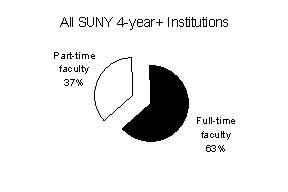
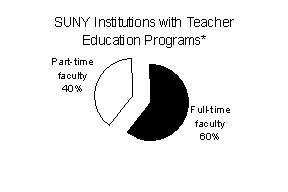
CUNY
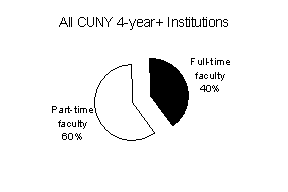
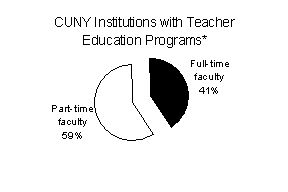
Independent Colleges and
Universities
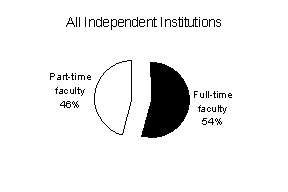
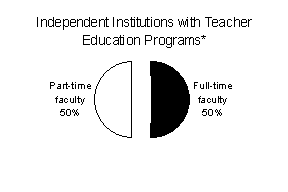
*
includes all full-time and part-time faculty in the entire institution,
not just those in teacher education programs
Ø
Other professional education programs
registered by the State Education Department are not required to maintain a
minimum percentage of full-time faculty, nor are they required to establish
faculty workload limits although percentages are recommended. Colleges and universities offering
licensure-qualifying programs in medicine, nursing, architecture, engineering,
public accountancy, dentistry, and other professions maintain high standards of
quality while exercising discretion to establish staffing plans in those program
areas.
Ø
Statewide data indicate that colleges and
universities in New York have enhanced the diversity of their faculty by hiring
a significant proportion of part-time faculty from minority populations:
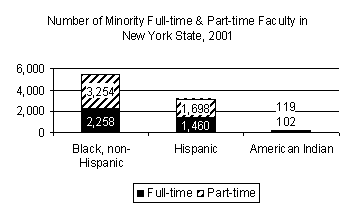
Ø
Nationally, according to the U.S. Department
of Education’s 1999 National Study of Postsecondary Faculty, approximately two
out of five faculty members in colleges and universities are teaching as
part-time faculty or instructors.
Collectively, these individuals teach approximately 40 percent of all
credit-bearing courses (Clery, 2001).
While the highest proportion of part-time faculty are teaching in
community colleges, part-time faculty were also widely employed in private and
public liberal arts, comprehensive, doctoral-degree granting and research-based
institutions.
Part-time faculty have many characteristics
that position them to be effective teachers and to help postsecondary students
achieve academic success. Research
shows that part-time faculty are motivated, dedicated to their field of
expertise, and eager to teach.
Part-time faculty have been found to have high levels of professional and
institutional engagement. On
average, part-time faculty are employed by the same institution for seven years
(Leslie, 1998). Leslie (1998) found
that over 85 percent of part-time faculty participating in the 1993 National
Study of Postsecondary Education reported that they were either satisfied or
very satisfied with their part-time positions. As compared to their full-time
counterparts, part-time faculty spend no less time on professional
development. A greater percentage
of part-time faculty (67.9 percent as compared to 48.3 percent of full-time
faculty) reported being satisfied with their ability to keep pace with
developments and changes in their field of expertise. While the expectations placed on
part-time faculty to be published are generally not as high as the expectations
of full-time faculty, one-third of part-time faculty reported completing
publications within two years prior to being surveyed. In their book, The Invisible Faculty, Gappa and Leslie
(1993) contend that only 10 to 15 percent of part-time faculty are aspiring
academics. Many part-time faculty
are full-time professionals eager to share their expertise and experience with
students and aspiring professionals.
Selected
Resources
Clery, S. “Part-time faculty”. NEA Higher
Education Research Center Update. September 2001, volume 7, number
4.
Federal IPEDS Survey S - 2001, 1999, 1997
from the NYSED OHE Office of Research and Information Systems:
www.highered.nysed.gov/oris/
Gappa, J. & Leslie, D. (1993). The
Invisible Faculty: improving the status of part-timers in higher education.
San Francisco: Jossey Bass.
Leslie, D. (1998) “Part-time, adjunct, and
temporary faculty: the new majority?” Report of the Sloan Conference on
Part-time and Adjunct Faculty. New
York: Alfred P. Sloan Foundation.
